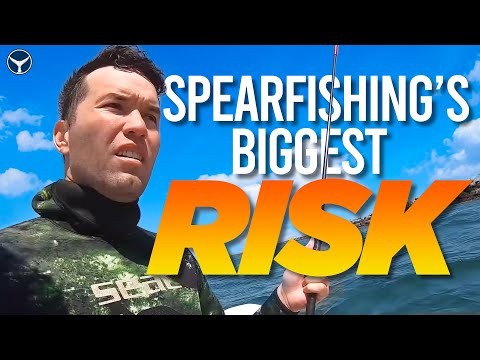I almost lost our buddy while spearfishing the oil rigs…
The day started like any other. I woke up early, threw my gear in the car, and met up at his house.
Everyone had smiles on their faces and were so welcoming with fresh croissant sausage sandwiches. This is the dream! Hanging out with good people on a boat and challenging ourselves to catch dinner at interesting dive spots.
Once we launched, we threw on the tunes and high-tailed it towards the rigs. The rigs look like massive floating cities straight out of a movie. Half Aquaworld and the other half Section 9, that South African alien movie from a while back. All floating on giant pylons in the middle of the ocean.
These pylons act as an artificial reef that houses some impressive fish. Plenty of good size California Sheephead, perch, and even some pelagic if you’re lucky.
But there is a danger when diving the rigs…The bottom is over 200 feet down.
No one is coming to get you if you mess up and sink. In the back of our minds we thought about it but no time to think about that now – the fish were waiting.
We needed fish for our BBQ and focused on going all in. Wetsuit, goggles, snorkel, weight belt, fins, GoPro and speargun…check!
Time to dive!
Mistake #1 – No Plan
With the exception of our captain, we were all in the water. Our first mistake was not deciding who our dive buddies were going to be before jumping in.
No plan is a bad plan.
A few guys had game bags on and wanted to go for scallops around 60 feet while others broke off to find some fish. I’m the weakest diver in the group, so I hung at the surface watching guys go up and down to make sure someone had an eye on them.
Watching many people at the same time isn’t efficient and is useless if they don’t dive close together.
Something didn’t feel right about the situation. A few months back I remember browsing Instagram and stumbling on Immersion Freediving. A guy named Ted was warning divers of the dangers of freediving.
Ted showed some videos of what a shallow water blackout looked like and while I was floating, I started realizing that if that were to happen here…it’s game over.
Mistake #2 – Game Bag Disaster
After spending some time diving and shooting a few fish, I ended up breaking off with my buddy Matt and Darren. We talked it out and decided that we’d be more strategic and dive one up one down and alternate.
After a few dives, I was floating at the top waiting my turn when Darren took a dive and then Matt. I remember thinking, “What happened to one-up, one-down guys?!”
Although they can both hold their breath for several minutes I had this feeling something wasn’t right. I decided to stay closer to Matt. He didn’t have a floatline to tell me where he was in the murky water, but I knew he typically comes up roughly where he dives down.
Suddenly I see him down about 15 feet with weird hand gestures and glossy eyes. I’ve seen this situation from videos Ted has shown about shallow water blackouts.
Flashbacks of Ted’s freediver safety online course popped in my head. I remember him saying that if your buddy is in trouble grab their armpit and protect the airway.
As soon as Matt broke the surface my hand was under his armpit and then it was lights out. Matt was diving heavy and also had a huge fish still attached to his reel pulling him down. One hand wasn’t enough for me to keep him above the surface, so I ditched my gun and put my other hand under his second armpit.
I was in the middle of the ocean, under a massive oil rig, treading water for myself and my deadweight buddy…I was in panic mode. I’ve never practiced this situation. The only thing I could think of was treading over to a pylon and pinning him to support his weight. Then after I could assess the situation.
As I was brainstorming how to release his weight belt and cut his spear free Matt suddenly woke up. “Where’s my gun?!” he exclaimed. I remember thinking, “Why do you care about your gun right now, you almost died!”
Then Ted’s course flashed back again where he stated that most freedivers blackout after breaking the surface and will tend to not recall blacking out. I asked, “Did you blackout?” (knowing full well he did) to which he replied, “No I didn’t blackout!”
The mind in survival mode is nuts!
What Went Wrong?
The game bag almost killed him. When Matt was at 65 feet (which is near his limit and the point to swim up) he spotted a big sheepshead.
He decided to line up and take the shot. But then he hit the fish it darted behind a pylon. As he shot up for the surface his reel got caught on his game bag and jammed. He was anchored around 40 feet down.
He grabbed his knife, but instead of cutting his reel line he tried to cut the game bag. Unfortunately, the game bag is made of tough cord and wouldn’t cut. If his reel handle didn’t break at the perfect time he wouldn’t have made it out since I couldn’t see him that far down.
Scary.
Where’s Darren?
I was nervous because, after the blackout ordeal, I got scared and remembered that Darren never came back. Horrible visions flashed through my mind that he was at the bottom of the ocean. I dreaded having to face his family as the guy who dragged him out diving that day.
Thankfully he was already back on the boat. After I debriefed the guys on what happened, Darren recounted his own similar experience which apparently happened simultaneously…
We all dodged a bullet on that one.
Safety Tips You Should Know
I highly recommend that you take Immersion Freediving’s free safety course if you haven’t already done so. However, if you’ve already taken a similar course or just want the cliff notes – here’s what he recommends so that we’re all safe:
- Dive in a team with one leader and one follower. One diver goes down at a time. If you dive deeper than 65 feet, then you’ll want to meet your partner about 1/3 the way down and follow them up.
- If diving in bad viz it’s smart to use a floatline to mark where you’re diving.
- If someone shallow water blackouts, grab their armpit to keep them from sinking and protect their airway. Protect the airway by placing your hand in front of their chin to prevent their face from falling in the water. Put them on their back, remove their mask by pinching the nose pocket, and “Blow, Tap Talk” three times. Blowhard across their eyes, tap their cheek and tell them to breathe.
- Don’t dive negatively buoyant and test yourself before your dive. Don’t be afraid to ditch the weight belt if your blacked out buddy is too heavy to float.
- Don’t dive with the snorkel in your mouth as it will funnel water into your lungs if you lose motor control from your blackout.
Although I didn’t do Ted’s method perfectly, I did remember enough to save my friend. Grab the armpit and protect the airway!
Thanks, Ted for helping me think quick under pressure!
If you want to take Ted’s free course, check out www.freedivingsafety.com. It just might save your buddy’s life.


